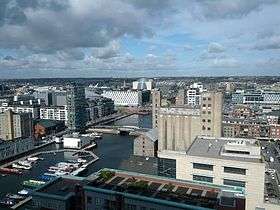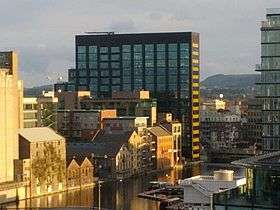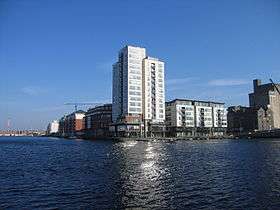Grand Canal Dock


Grand Canal Dock (Irish: Duga na Canálach Móire) is an area near the city centre of Dublin, in the easternmost part of Dublin 2 and the westernmost part of Ringsend in Dublin 4, surrounding the Grand Canal Docks, an enclosed harbour or docking area between the River Liffey and the Grand Canal. Since 2000 the area has undergone significant redevelopment as part of the Dublin Docklands area redevelopment project.
The Grand Canal Dock area is somewhat disputed. It is generally understood to be bounded by the Liffey to the north, South Lotts Road to the east (or Barrow Street if separating South Lotts as its own area), Grand Canal Street to the south and Macken Street to the west (although current maps show the area including as far west as the corner of Leeson Street and Fitzwilliam Place). Grand Canal Dock contains Grand Canal Dock railway station (also known as Barrow Street Station), the national Waterways Ireland Visitor Centre, the U2 Tower site, and a number of notable buildings.
The area has been dubbed "Silicon Docks"[1][2][3] (a reference to Silicon Valley) as it has become an extremely popular location for high-tech multinationals such as Google,[4] Facebook,[5] Twitter,[6] Linkedin,[7] Airbnb,[8] and more.
Grand Canal Dock railway station, accessed from Barrow Street, opened in 2001 (although the commuter line has been in use since 1834). In early 2014, five new Dublin Bikes stations were opened in the area.
History
The Grand Canal Docks first opened in 1796. At the time they were the world's largest docks. They fell into decline within just a few decades, due mostly to disuse with the arrival of the railways. The landscape was overwhelmed by Dublin Gas Company's mountains of black coal, along with chemical factories, tar pits, bottle factories and iron foundries. However, bakers and millers maintained business along the southern edge of the inner basin.[9]
By the 1960s, the Grand Canal Docks were almost completely derelict. By 1987, it was decided that Hanover Quay was too toxic to sell. Regeneration began in 1998, when Bord Gáis sold the Dublin Docklands Development Authority (DDDA) the former gasworks site located in the area between Sir John Rogerson's Quay and Hanover Quay for €19 million. The DDDA spent €52 million decontaminating the land, even though the likely return was estimated at just €40 million. The decontamination took place under the supervision of the Environmental Protection Agency between 2002 and 2006. The process involved constructing an underground wall eight metres deep around the affected area and the contaminated land dug out and removed. By the time the decontamination was finished, an inflated property bubble and increased demand in the area (brought on, in part, by the decision by Google to set up its European headquarters nearby), allowed the authority to sell the land for €300 million. The DDDA injected some of its new wealth into the area's infrastructure including seers, street lighting, and civic spaces.[10]
A number of significant developments have happened since involving the construction of millions worth of real estate, the arrival of several thousand new residents, and the establishment of what is now known as Silicon Docks.
Sites control and planning
On 22 May 2014, it was announced that a fast-track planning process was approved by An Bord Pleanala. 366,000 square metres of office space and 2,600 homes will be developed across 22 hectares of land in the North Lotts and Grand Canal Dock areas under the Docklands Strategic Development Zone (SDZ) planning scheme.[11] A number of site plan notices have been posted in the area including the following:
- On 14 October 2014, it was reported that U2 would buy 16 Hanover Quay from the Dublin Docklands Development Authority for €450,000.[12] The authority had forced the band to sell its old riverfront studio on Hanover Quay for an undisclosed price in 2002 to allow development of the Grand Canal Harbour area. As part of that deal the authority had promised the band the top two floors of the 32-storey tower it was planning to build on an adjacent quay, a project that was subsequently put on hold. In light of its imminent dissolution and the recent approval by An Bord Plenala for the North Lotts and Grand Canal Planning scheme, the authority decided it would not be proceeding with a proposed compulsory purchase order of 16 and 18 Hanover Quay.
- On 4 December 2014, a site plan notice was posted describing the developments to take place at the Boland's Mill site including retaining and restoring old stone buildings to accommodate retail/restaurant/cafe use, cultural/exhibition use, and residences; and the construction of three new towers (13 to 15 storeys, maximum height 53.65m) to accommodate offices and residences. There will also be three new pedestrian routes from Barrow St., new civic waterfront square adjacent to the dock.
- On 12 December 2014, two site plan notices were posted for Targeted Investment Opportunities PLC describing the developments to take place at the former Kilsaran Concrete site at 5 Hanover Quay. One notice is for the construction of a 7 storey office building. The other notice is for the construction of a 7-8 storey building to accommodate residences and mixed-use, including 100 apartments, a leisure centre, and space for 1 retail and 2 cafes at ground level.
Buildings
Most of the buildings surrounding Grand Canal Square such as the Bord Gáis Energy Theatre, The Marker Hotel, and HQ office development, were developed by McCauley Daye O’Connell Architects.[13] Notable buildings in the Grand Canal Dock area include:
Alto Vetro
The Alto Vetro apartment building was awarded the Royal Institute of the Architects of Ireland’s (RIAI) Silver Medal for Housing (2007-2008).[14] It was built by the Montevetro developers Treasury Holdings.
Boland's Mill
Boland's Mill was a functioning mill until 2001. The site, including older stone buildings and taller concrete silos, is now derelict. As of August 2015, the site is currently undergoing a €150 million reconstruction to become Bolands Quay, accommodating new residences, commercial, retail, and civic spaces.[15]


Bord Gáis Energy Theatre
The Bord Gáis Energy Theatre is the largest theatre in Ireland. It designed by Polish-American architect Daniel Liebeskind. It was opened as the Grand Canal Theatre in 2010 but renamed in March 2012 as part of a paid naming rights agreement.[16]
The Factory
The Factory houses Irish Film and Television Network studios, as well as rehearsal and recording studios where a number of U2's albums were recorded.
Google Docks
The Montevetro building completed in 2010 stands at a height of 67 metres and is currently the tallest commercial building in Dublin. It was sold to Google in January 2011 and subsequently renamed "Google Docks".[4] In 2014, the Google Docks building was joined by an "iconic" curving three-pronged steel and transparent glass footbridge to Google's two office buildings across Barrow Street - Gordon House and Gasworks House. It has been named "Hyperlink".[17][18]
The Marker Hotel
The Marker Hotel is one of only six of The Leading Hotels of the World in Ireland. It was designed in 2004 by Portuguese architect Manuel Aires Mateus. It opened in 2013, and offers the city’s first rooftop terrace and bar.[13]
Millennium Tower
Millennium Tower is an apartment building located on the Grand Canal outer basin. At 63 metres in height, it was the tallest storied building in Dublin from 1998 - 2009.
Nos. 2, 4, and 5 Grand Canal Square
The modern office buildings alongside the Bord Gáis Energy Theatre were designed by architect Daniel Liebeskind and developed by Chartered Land. No 2 houses offices for William Fry Solicitors. No 4 houses offices for Facebook's European headquarters.[2]
See also
References
- 1 2 Barber, Lynsey (17 June 2014). "In pictures: Inside Facebook's new Dublin office and European HQ". Retrieved 15 October 2014.
- ↑ "Facebook to move to bigger Dublin offices". RTÉ. 7 November 2014.
- 1 2 Dillon-Scott, Piers (29 January 2012). "Google to open 'Google Docks' in Dublin". The Sociable.
- ↑ O'Brien, Ciara (7 November 2013). "Facebook confirms move for Dublin HQ to bigger premises". Irish Times.
- ↑ Parfeni, Lucien (26 September 2011). "Twitter Joins Google, Facebook and Sets Up International HQ in Dublin, Ireland". Softpedia.
- ↑ "LinkedIn to open HQ in Dublin". Irish Independent. 30 November 2012.
- ↑ Lyons, Tom (18 January 2014). "Airbnb finds its home in Dublin 4". Irish Times.
- ↑ Bunbury, Turtle (1 Jan 2009). Dublin Docklands - An Urban Voyage. Montague Publications Group. p. 251. ISBN 9780955815515.
- ↑ Newenham, Pamela (19 January 2015). Silicon Docks: The Rise of Dublin as a Local Tech Hub. Liberties Press. p. 200. ISBN 9781910742006.
- ↑ Melia, Paul (23 May 2014). "Green light for massive Docklands development". The Independent.
- ↑ Taylor, Charlie (14 October 2014). "U2 to buy Hanover Quay site from DDDA for €450,000". Irish Times.
- 1 2 "The Marker Hotel". Irish Building Magazine. 10 September 2013.
- ↑ "Grand Canal Quay's Alto Vetro Wins RIAI's Silver Medal for Housing". Royal Institute of the Architects of Ireland. 13 September 2011.
- ↑ Kelly, Olivia (2015-07-02). "Green light for €150m Boland's Mill development". The Irish Times. Retrieved 10 September 2015.
- ↑ "Grand Canal Theatre to change name as part of Bord Gáis deal". Irish Times. 25 October 2011.
- ↑ Coyle, Colin (1 April 2012). "Google plans bridge to link three Dublin offices". The Sunday Times.
- ↑ "Works Start on Google Bridge". Bennett Construction. 17 February 2014.
| Wikimedia Commons has media related to Grand Canal Dock. |
Coordinates: 53°20′37″N 6°14′15″W / 53.343497°N 6.23762°W